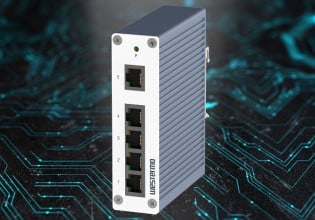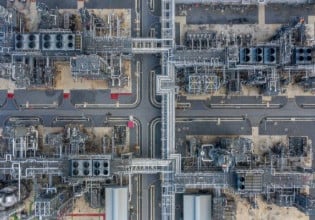An Introduction to Air Quality Measurement and Sensors
This article introduces the role of air quality measurement in factories and manufacturing facilities. It also covers the different sensors available for air quality measurement systems.
Air quality measurements track the environmental air and detect dangerous, un-wanted gases and particulates in the air. Often these particulates and materials are invisible to the human eye, but their effect on humans and the environment can be significant.

Figure 1. Air quality measurement is important to protect personnel and the environment.
Due to their manufacturing processes, industries such as petrochemical, power, and construction can affect the environment with different chemicals, pollutants, and materials. To prevent environmental contamination and ensure healthy working conditions, industries employ air quality measurements. These measurements help to take appropriate protective measures to protect both the population and the environment.
Technology for Air Quality Measurements
The technology sensors use depends on whether the measurements are for gas or particulates. Gases react differently per their basic structural phenomenon, so the measuring entity is responsible for defining the technology a sensor uses. The following are common technologies air quality measuring devices use.
Electrochemical
These sensors work on the principle of a chemical reaction between a gas and the electrode inside the instrument. When an electrode inside the sensor detects the sample gas, a chemical reaction takes place. The chemical reaction can be Oxidation or Reduction, and this reaction generates analog current. The analog current value corresponds to the gas concentration.
Sensors for measuring nitrogen dioxide, sulfur dioxide, ozone, nitrogen monoxide, and carbon monoxide use this phenomenon. These sensors are sensitive to external factors, including temperature and humidity.
Metal Oxide
In this technology, a metal oxide semiconductor’s conductivity is measured, which in turn represents the amount of gas. When a gas interacts with the semiconductor material, oxidation or reduction takes place. An oxidizing gas reduces the conductivity and reducing gases increases the conductivity of the semiconductor. This increase or decrease in the conductivity changes the electrical characteristics and appropriate sensors detect these characteristics and gives output in a form of gas concentration.

Figure 2. An example of how metal oxide sensors work. This particular diagram shows MOXSens Technology created by Sensirion. Image courtesy of Sensirion.
This technology is used in sensors that measure nitrogen dioxide, ozone, and carbon monoxide.
Photoionization
Sensors that detect volatile organic compounds (VOC) use photoionization technology. These are the compounds that have a low boiling point at room temperature. Due to this characteristic, they evaporate at room temperature, earning them the label “volatile.”
In these detectors, the compound’s ionization takes place as the ultraviolet lamp emits photons. The electrodes collect these ions, whether negative or positive charge. The electrode’s output correlates with the VOC’s concentration.
Many volatile gases fall under the category of VOC, so these detectors cannot identify any single gas. Instead, they indicate the general amount of VOC present in the environments.
Optical Sensor
Sensors that detect particulate matter (PM) use optical sensors. PM consists of solid and liquid particles. When these particles are inhaled by humans, serious health problems could result.
These sensors work by measuring the amount of light scattered by the particles as the sample air passes through a beam of light. The light is scattered due to the concentration of particulates in the sample air, and the detector’s algorithm converts the scattering pattern into particulate size and amount. The reading of these sensors depends upon several physical particle parameters such as shape, color, and density.

Figure 3. Block diagram of the overall structure of an optical sensor. Image courtesy of Omron.
The optical sensing technology is also used for different gases such as CO and CO2.
Implementing Air Quality Systems in Large Facilities
Measuring the air quality of a manufacturing or an industrial facility through the use of manual instruments is challenging. This includes but is not limited to the practice that the measurements only represent a single point, one reading at a time. These instruments are expensive and require technical expertise to operate and generate output. Accurate historical trends can be difficult to track, as the real-time data is hard to obtain and maintain.
Solution: Air Quality Sensors
The answer to all the restrictions of manual monitoring is to deploy air quality sensors.
Air quality sensors installed across the facility enable the acquisition of automatic data without involving humans. The frequency of the data collected depends upon the factory or as required by regulatory bodies and is customized for specific requirements. The data is stored on the central network and can be accessed when necessary. The monitoring interface or dashboard displays different reports such as real-time data and error details. The historical trend over a day, month, or year wise is also possible.
These measurements can be verified through manual instruments, comparing the readings with those from air quality sensors.
Air Quality Measurement and HVAC
Air quality measurements are an important part of HVAC implementation. Measuring different gases and particulate matters ensures the HVAC system is operating according to set standards. The readings from different air quality sensors also indicate the actual air present in the surrounding environment and the inner workings of different subsystems of the larger HVAC system.
Measuring levels of carbon dioxide and other gases inform operators of the air quality. Operators get an idea of air quality, as too much carbon dioxide levels indicate an oxygen shortage. The same is the case with carbon monoxide, particulates, and VOCs.
As a result of these readings, different HVAC subsystems can be analyzed for satisfactory working. The analysis covers particulate readings for filter sections, whereas different gas readings give an idea of airflow sections, including the air blower, exhaust, and inlet damper.
Air Quality Measurement’s Role in Facility Safety
Air quality measurements give facility personnel a clear picture of airflow in a facility or building. Too high or low levels of different gases indicate an erratic airflow stream inside a building. This not only causes danger to human health but also results in an increased cost of maintaining the air quality requirements of a facility or a building. Poor air quality measurements can also indicate a threat to the environment.





